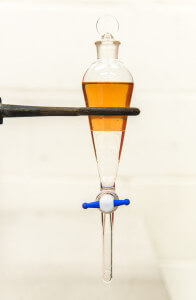Bionic liquids – solvents composed of lignin and hemicellulose, two by-products in the production process of biofuels – hold great promise for economic improvement within biofuel refineries.
[Translation by Dr. Nachmani Moshe]
Bionic liquids – solvents composed of lignin and hemicellulose, two by-products in the production process of biofuels – hold great promise for economic improvement within biofuel refineries.

While the powerful solvents known as ionic liquids are a great promise for the efficient use of sugars in the production process of biofuels, even more promising solvents appear on the horizon - ionic liquids.
Researchers from a research institute affiliated with the US Department of Energy (JBEI) have developed "bionic liquids" from lignin and hemicellulose, two by-products in the production process of biofuels received in biofuel refineries. Says Blake Simmons, a chemical engineer who serves as director of science and technology at the research institute: "The substance lignin (Wikipedia) Recognized as a waste product that is usually burned in order to generate heat and electricity from it in bio-fuel refineries; However, if it is possible to find other uses of higher economic value for lignin, the result will significantly improve the overall costs in these refineries. Our idea of ionic liquids opens a window to obtain a closed-loop process for refineries that produce biofuels, and it has considerable economic implications for the technologies of other processes based on ionic liquids, which are currently synthesized from oil." The research findings were recently published in the scientific journal Proceedings of the National Academy of Sciences (PNAS).
The cellulosic sugars stored in the biomass of grass, other non-food plants, and agricultural waste can all be used to produce advanced biofuels that could ultimately reduce the overall use of fossil fuels, which are responsible for the annual emission of nearly 9 billion cubic tons of carbon to the atmosphere. Over a billion tons of biomass are produced every year in the US alone, and the fuels that can be produced from this biomass may be clean, green and renewable substitutes for gasoline, diesel and jet fuel. Unlike ethanol, the transport of fuels produced from biomass can reach the consumer directly as part of the operation of engines, without affecting their operational performance.
At the same time, if we intend to use biofuels, including cellulosic ethanol, commercially, their production methods must be more economical than those based on fossil fuels. This means that economic technologies must be developed in order to extract those sugars from the biomass and convert them into fuels and other useful chemical products. The main challenge was that, unlike the simple sugars found in corn kernels, the complex polysaccharides found in biomass are deeply embedded in a woody material called lignin. The researchers were able to convert biomass into sugars used as raw materials for biofuels with the help of ionic liquids - salts consisting of ion pairs that are liquid at room temperature. The ionic liquids born out of this research team's efforts as a benchmark for biomass processing are imidazole-based salt melts, produced from non-renewable sources, such as oil or natural gas.
"Imidazole-based ionic liquids manage to dissolve biomass effectively, and represent an exceptional starting point for biomass pretreatment, but these materials are expensive and therefore their industrial use is limited," explains the lead researcher. "In order to replace them with a new product, we were able to synthesize a series of ionic liquids based on quaternary amines from aromatic aldehydes in lignin and hemicellulose."
The researchers tested the effectiveness of their bionic fluids as a pre-treatment to discharge the biomass of a species of switchgrass, which is one of the plants with high potential for making liquid transportation fuels. After 73 hours of incubation with these new biofluids, sugar utilization was in the range of 95-90% for glucose, and in the range of 75-70% for the sugar xylose. These recoveries are comparable to recoveries obtained after pretreatment with the best imidazole-based ionic liquids.
"Lignin and hemicellulose are by-products of the agricultural industry, biofuel plants and wood pulp processing plants, which not only makes these common polymers cheap, but also enables the development of closed-loop refineries, where the lignin derived from the waste stream can be used Going back to make liquid in another June," said the lead researcher. The current biofluids were synthesized using redox amination and phosphoric acid, but the research team is now exploring the possibility of using alternative reagents that would be less expensive and even more environmentally friendly. "Our findings present an important starting point for future research of bionic fluids in the field of biofuels and other industrial fields," said the lead researcher.
